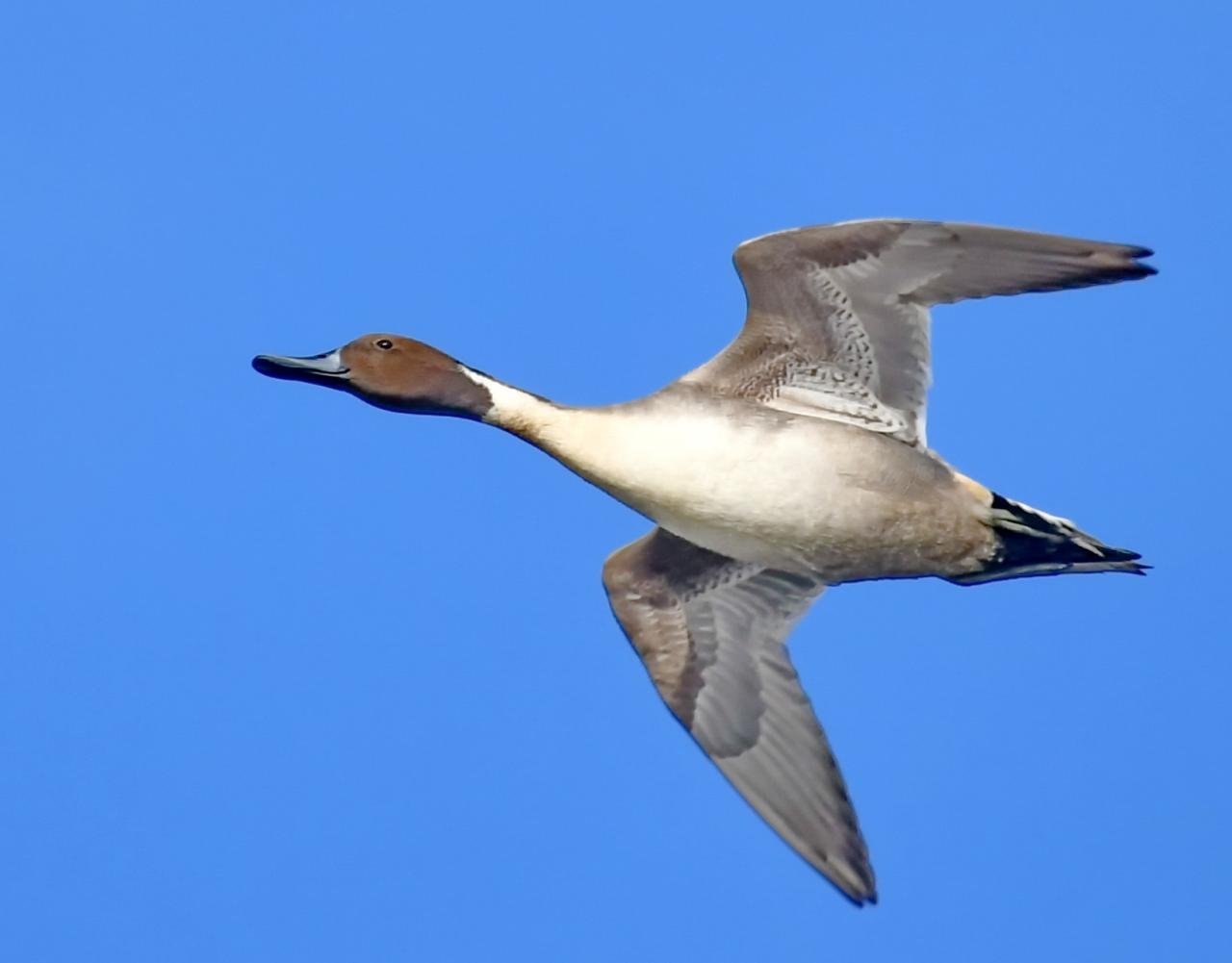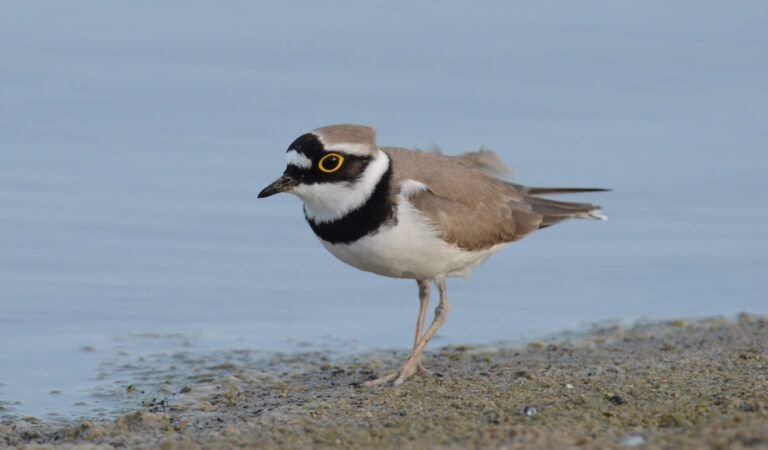The pintail or northern pintail (Anas acuta) is a duck with wide geographic distribution that breeds in the northern areas of Europe, Asia and North America. It is migratory and winters south of its breeding range to the equator. Unusually for a bird with such a large range, it has no geographical subspecies if the possibly conspecific duck Eaton’s pintail is considered to be a separate species.
This is a large duck, and the male’s long central tail feathers give rise to the species’ English and scientific names. Both sexes have blue-grey bills and grey legs and feet. The drake is more striking, having a thin white stripe running from the back of its chocolate-coloured head down its neck to its mostly white undercarriage. The drake also has attractive grey, brown, and black patterning on its back and sides. The hen’s plumage is more subtle and subdued, with drab brown feathers similar to those of other female dabbling ducks. Hens make a coarse quack and the drakes a flute-like whistle.
The northern pintail is a bird of open wetlands which nests on the ground, often some distance from water. It feeds by dabbling for plant food and adds small invertebrates to its diet during the nesting season. It is highly gregarious when not breeding, forming large mixed flocks with other species of duck. This duck’s population is affected by predators, parasites and avian diseases. Human activities, such as agriculture, hunting and fishing, have also had a significant impact on numbers. Nevertheless, owed to the huge range and large population of this species, it is not threatened globally.
This species was first described by Linnaeus in his Systema naturae in 1758 as Anas acuta. The scientific name comes from two Latin words: anas, meaning « duck », and acuta, which comes from the verb acuere, which means « sharpen »; the species term, like the English name, refers to the pointed tail of the male in breeding plumage. Within the large dabbling duck genus Anas, the northern pintail’s closest relatives are other pintails, such as the yellow-billed pintail (A. georgica) and Eaton’s pintail (A. eatoni). The pintails are sometimes separated in the genus Dafila (described by Stephens, 1824), an arrangement supported by morphological, molecular and behavioural data. The famous British ornithologist Sir Peter Scott gave this name to his daughter, the artist Dafila Scott.
Eaton’s pintail has two subspecies, A. e. eatoni (the Kerguelen pintail) of Kerguelen Islands, and A. e. drygalskyi (the Crozet pintail) of Crozet Islands, and was formerly considered conspecific with the northern hemisphere’s northern pintail. Sexual dimorphism is much less marked in the southern pintails, with the male’s breeding appearance being similar to the female plumage. Unusually for a species with such a large range, northern pintail has no geographical subspecies if Eaton’s pintail is treated as a separate species. A claimed extinct subspecies from Manra Island, Tristram’s pintail, A. a. modesta, appears to be indistinguishable from the nominate form.
The northern pintail is a fairly large duck with a wing chord of 23.6–28.2 cm (9.3–11.1 in) and wingspan of 80–95 cm (31–37 in). The male is 59–76 cm (23–30 in) in length and weighs 450–1,360 g (0.99–3.00 lb), and therefore is considerably larger than the female, which is 51–64 cm (20–25 in) long and weighs 454–1,135 g (1.001–2.502 lb). The northern pintail broadly overlaps in size with the similarly-widespread mallard, but is more slender, elongated and gracile, with a relatively longer neck and (in males) a longer tail. The unmistakable breeding plumaged male has a chocolate-brown head and white breast with a white stripe extending up the side of the neck. Its upperparts and sides are grey, but elongated grey feathers with black central stripes are draped across the back from the shoulder area. The vent area is yellow, contrasting with the black underside of the tail, which has the central feathers elongated to as much as 10 cm (3.9 in). The bill is bluish and the legs are blue-grey.
The adult female is mainly scalloped and mottled in light brown with a more uniformly grey-brown head, and its pointed tail is shorter than the male’s; it is still easily identified by its shape, long neck, and long grey bill. In non-breeding (eclipse) plumage, the drake pintail looks similar to the female, but retains the male upperwing pattern and long grey shoulder feathers. Juvenile birds resemble the female, but are less neatly scalloped and have a duller brown speculum with a narrower trailing edge.
The pintail walks well on land, and swims well.It has a very fast flight, with its wings slightly swept-back, rather than straight out from the body like other ducks. In flight, the male shows a black speculum bordered white at the rear and pale rufous at the front, whereas the female’s speculum is dark brown bordered with white, narrowly at the front edge but very prominently at the rear, being visible at a distance of 1,600 m (0.99 mi).
The male’s call is a soft proop-proop whistle, similar to that of the common teal, whereas the female has a mallard-like descending quack, and a low croak when flushed.
This dabbling duck breeds across northern areas of Eurasia south to about Poland and Mongolia, and in Canada, Alaska and the Midwestern United States. It winters mainly south of its breeding range, reaching almost to the equator in Panama, northern sub-Saharan Africa and tropical South Asia. Small numbers migrate to Pacific islands, particularly Hawaii, where a few hundred birds winter on the main islands in shallow wetlands and flooded agricultural habitats. Transoceanic journeys also occur: a bird that was caught and ringed in Labrador, Canada, was shot by a hunter in England nine days later, and Japanese-ringed birds have been recovered from six US states east to Utah and Mississippi. In parts of the range, such as Great Britain and the northwestern United States, the pintail may be present all year.
The northern pintail’s breeding habitat is open unwooded wetlands, such as wet grassland, lakesides or tundra. In winter, it will utilise a wider range of open habitats, such as sheltered estuaries, brackish marshes and coastal lagoons. It is highly gregarious outside the breeding season and forms very large mixed flocks with other ducks.
Both sexes reach sexual maturity at one year of age. The male mates with the female by swimming close to her with his head lowered and tail raised, continually whistling. If there is a group of males, they will chase the female in flight until only one drake is left. The female prepares for copulation, which takes place in the water, by lowering her body; the male then bobs his head up and down and mounts the female, taking the feathers on the back of her head in his mouth. After mating, he raises his head and back and whistles.
Breeding takes place between April and June, with the nest being constructed on the ground and hidden amongst vegetation in a dry location, often some distance from water. It is a shallow scrape on the ground lined with plant material and down.The female lays seven to nine cream-coloured eggs at the rate of one per day; the eggs are 55 mm × 38 mm (2.2 in × 1.5 in) in size and weigh 45 g (1.6 oz), of which 7% is shell. If predators destroy the first clutch, the female can produce a replacement clutch as late as the end of July. The hen alone incubates the eggs for 22 to 24 days before they hatch. The precocial downy chicks are then led by the female to the nearest body of water, where they feed on dead insects on the water surface. The chicks fledge in 46 to 47 days after hatching, but stay with the female until she has completed moulting.
Around three-quarters of chicks live long enough to fledge, but not more than half of those survive long enough to reproduce.The maximum recorded age is 27 years and 5 months for a Dutch bird.
The pintail feeds by dabbling and upending in shallow water for plant food mainly in the evening or at night, and therefore spends much of the day resting.Its long neck enables it to take food items from the bottom of water bodies up to 30 cm (12 in) deep, which are beyond the reach of other dabbling ducks like the Mallard.
The northern pintail is one of the species to which the Agreement on the Conservation of African-Eurasian Migratory Waterbirds (AEWA) applies, but it has no special status under the Convention on International Trade in Endangered Species of Wild Fauna and Flora (CITES), which regulates international trade in specimens of wild animals and plants.




